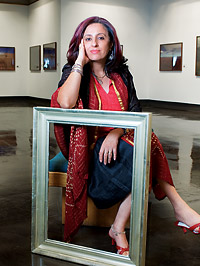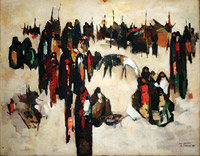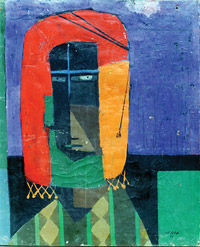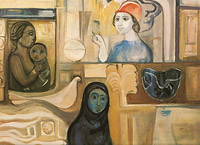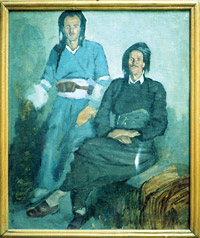 |
|||||||||||||||||

International Network for Contemporary Iraqi Artists The American Academic Research Institute in Iraq Lost Treasures
|
Known as one of the world’s leading authorities on contemporary Iraqi art, the UNT assistant professor of art history has dedicated herself to documenting artwork missing and stolen from the Iraqi Museum of Modern Art in Baghdad. The museum was damaged by fire and looting after bombings in 2003. Shabout’s quest to preserve contemporary Iraqi art has taken her into dangerous territory to save a part of Iraqi culture and history that might otherwise disappear forever. Sculptures as bird cages After bombings during the U.S.-led invasion in 2003, looters struck the Iraqi Museum of Modern Art, formerly known as the Saddam Center for the Arts, cutting canvases from the frames and using the wood for fuel. Sculptures ended up as bird cages on balconies. Priceless works sold on the black market for a few hundred dollars.
Looters also hit the Iraqi National Museum, the home of ancient art and antiquities. But the National Museum, filled with Mesopotamian art that people so readily associate with Iraq, received attention, Shabout says. The problem at the modern art museum, she says, seemed to fall by the wayside. The artwork cannot be proven missing from the museum without proper documentation. And the longer the work is gone, the more likely it will disappear forever into private collections or suffer damage beyond repair, she says. “The problem is, if the works are gone, the memory is gone,” she says. “And they will have never existed.” Return to Baghdad
Born in Scotland and of Iraqi descent, Shabout lived in Baghdad from age 6 until her graduation from the Baghdad High School for Girls. In 1980, she moved to the United States to pursue a college education, earning degrees in art and architecture from the University of Texas at Arlington. She returned to Baghdad for the first time in June 2003. Initially, she barely recognized the city, noticing the new highways and monuments added in the 1980s. Then, she saw familiar buildings, disguised by the pall of age and war.
“When I left Baghdad in 1980, it looked like a bright, clean city, but on this trip, it looked so rundown and dirty and old,” she says. “It was really sad.” Walking on five inches of dust — which was still swirling through the air after the bombings and covered roads, sidewalks and even building interiors — Shabout met artists outside their studios. The buildings, lacking electricity and air conditioning, were often too hot to enter. Shabout chased down rumors about the art from Iraqi artists, art dealers and gallery owners, learning whose son might have looted the museum and which gallery might have missing artwork. She used each nugget of information that she collected to move on to the next clue.
She attended several meetings at the United Nations headquarters in Baghdad. That August, a truck bomb exploded there, killing 17 people. She knew people who had been killed in the blast. “When you’re there, you’re careful, but you can’t be frightened, or you will be paralyzed,” she says. More than art About 1,500 of the 8,000 originals missing from the modern art museum have been retrieved and are being stored, Shabout says. She knows that retrieving all of the pieces would be next to impossible. Many are already in private collections, and buying them back would be too expensive.
Instead, she searches for existing photographs of the art and intends to create a catalog with images, titles, artist names, dates and dimensions of any piece owned by the modern art museum. In this way, she says, the memory will live on. Shabout has collected about 500 images of the missing pieces. She says she has learned not to become overly optimistic.
But she has seen victories, like the wooden statue called Motherhood by artist Jawad Salim. The work, which she compares to Picasso in the value of its importance for Iraqi art, was purchased off the black market in late 2003 for $100 or so. The statue is now at a Baghdad gallery until it can be returned to the museum. With the passage of time and increased violence, the situation has worsened, Shabout says, and information about cultural institutions is difficult to obtain because of censorship and a media blackout.
“Artists are migrating to any place that takes them,” she says. “But we also know of continuous destruction of the modern public monuments of Iraq.” Because of the dangerous situation, she has not been able to return to Iraq since 2003. Instead, she conducts research in Jordan and other nearby areas. Her search to document missing art is about more than the art itself, she says. “It’s about class, social systems and political systems. This is history — a document of what was created then,” she says. “It will give us a way of studying successive Iraqi cultures, parts of history that need to be documented. They complete the overall picture of the history of humanity.”
|
||||||||||||||||||||||||||||||||||||||||||||||||||||||||||||||||||||||||||||||||||||||||
